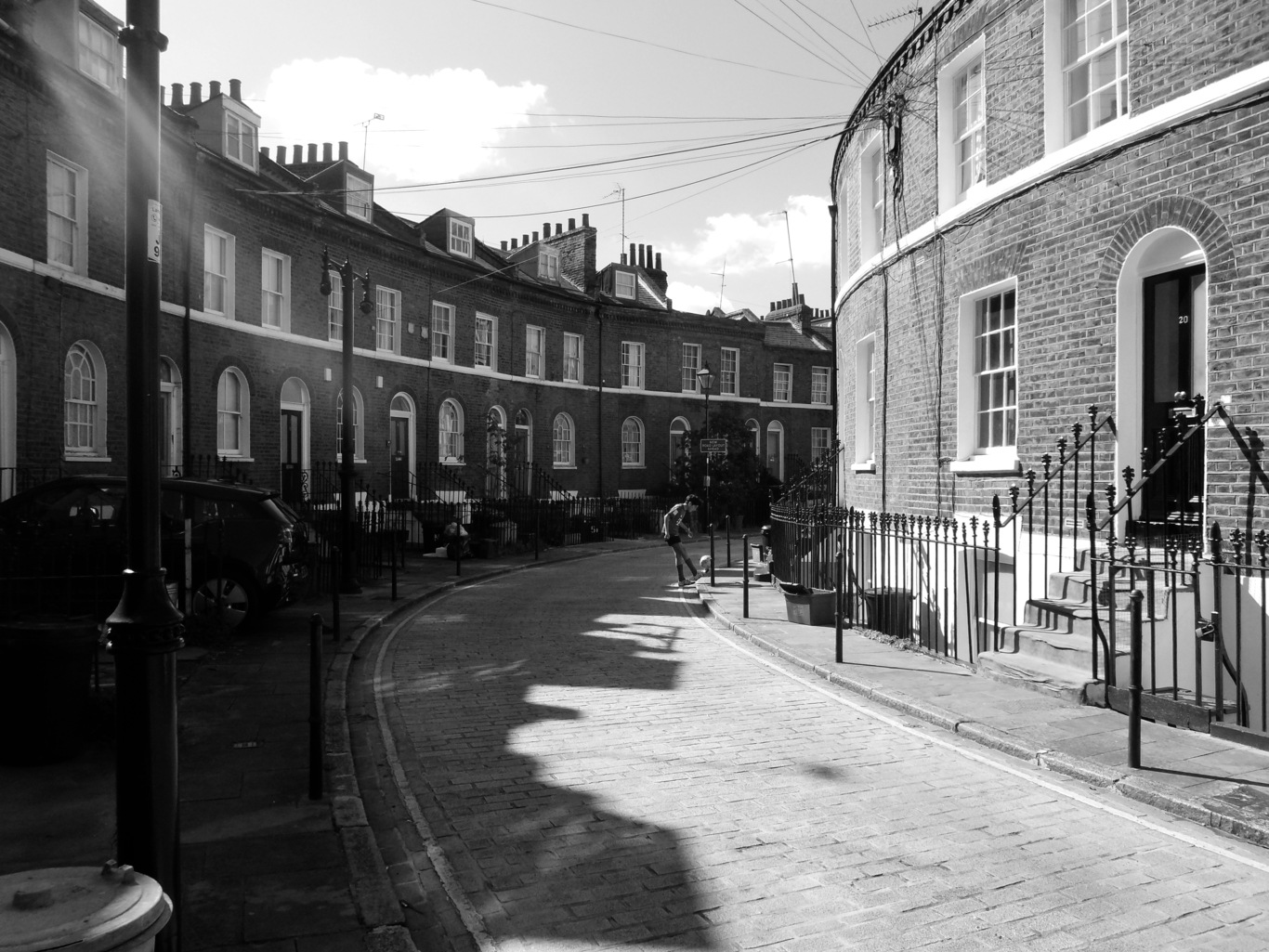If you are looking for a touch of magic around King’s Cross, head to Keystone Crescent. It’s an elegant, complete, hidden away semi-circle of early Victorian workers’ housing. Twenty-four houses, inner and outer circles, with a formidable curve: ‘the smallest radius of any crescent in Europe’ says a board which summarises the street’s history … we’ll take that on trust.
Bob Stuckey, a musician who lives in the outer circle, says the tight curve makes the street more friendly. “It creates a village feeling. There’s something about the dimensions that makes you want to say hello.” He’s lived in the Crescent – a “fantastic” spot – for more than fifty years. And he has a special connection to the place: his great-great-grandfather built it.
In the mid-1840s, Robert James Stuckey, the son of a Shoreditch bricklayer, built what was then Caledonia (later Caledonian) Crescent – the old name is still visible on a sign at the north end of the street. It took its name, as did Caledonian Road and Caledonia Street, from the nearby Caledonian Asylum for Scottish children.
The indefatigable Stuckey also built almost a hundred other properties in the area. It was a bold speculative move, probably influenced by the impending development of King’s Cross station – the Great Northern Railway was established by Act of Parliament in 1846 and its London terminal opened six years later. And it paid off big time.
LOCAL ADVERTISING
Stuckey’s burst of construction work shaped the southern end of Caledonian Road. And unlike many builders, who sold their properties as soon as they could, Stuckey rented out his houses. 2A Caledonian Crescent became his estate office. The family still owns seven buildings in the Crescent – two of which are the home of the builder’s direct descendants – as well as a swathe of commercial properties nearby and warehouse (part of a former bus garage) on Omega Place.
The houses on the outer circle have four floors, including a basement, with originally two rooms on each and a common toilet and wash-house in the back yard; the inner circle has three floors, and – because of the tight radius – slightly more cramped rooms and a smaller back garden.
Bob’s father was born in 2A and, at his request, his body lay in rest there so that friends and tenants could pay their respects. Later,when clearing up, Bob found a remarkable cache of letters under the bed written more than a century earlier, by Robert James Stuckey to his young grandchildren. That prompted Bob, himself the grandchild of one of these grandchildren, to pursue the story of the Crescent and its begetter.
These houses were not built for single families. Right from the start, they were in multiple occupation. Bob Stuckey has been through the 1851 census returns for the street. Five years after the houses were built, all but two were occupied; some had as many as seventeen people living in them. In total, 240 people, constituting 76 families, lived in the 22 properties. The occupations given suggest these were the homes of working families, with carpenters and masons well represented.
No one knows why Robert James Stuckey took to building a crescent rather than on a more conventional grid. It was perhaps the best (or most profitable) use of an irregularly sized patch of land. The houses don’t have much in the way of foundations, but they have stood the test of time.
That’s no thanks to Algernon Stuckey, the builder’s grandson, who was minded to pull down the Crescent. By the Edwardian era, the houses were a little down-at-heel. A report in the Builder in 1891 described an overcrowded street with inadequate drainage, abutting on open land used to keep poultry and ducks, pigeon coops and rabbit hutches, which was ‘without advantage … to the night’s rest of the neighbours’.
Algernon was as much concerned by the poor reputation of the area as a result of street prostitution. He was foiled in his redevelopment plans but did manage to rebrand the street. In 1917 it was renamed Keystone Crescent, the name reflecting a family interest in freemasonry in which the keystone is an important symbol.
Slightly tucked away but close to pubs and stations, it’s easy to see why the Crescent attracted sex workers. And the renaming hardly kept the sex trade at bay. When Bob Stuckey moved in, back in the 1960s, prostitutes would routinely bring their clients to the basement yards. “Sometimes they didn’t even bother to go down to the basements.”
It had also to weather a long period of planning blight. King’s Cross was at one time lined up as the terminus for the Channel rail link, and that would have involved the demolition of the entire street. But it’s now safe and indeed listed. And the sex workers have moved on. The worst the residents face now are youngsters gathering a little out of general view to smoke dope or to drink and carouse into the small hours. Fairly standard inner city stuff.
That hasn’t stopped prices for those Keystone Crescent properties that come on the market reaching seven figures. I imagine that Robert James Stuckey – now in a vault in the old wing of Highgate cemetery – will be pleased that his crescent has come into style.
Were you after the bar called Keystone Crescent? Read our review here
Please support us if you can
With the sad demise of our free monthly print titles across London last summer due to advertising revenues in freefall, we now need your support more than ever. Why? So we can keep delivering ‘good-news’ cultural stories that celebrate our neighbourhoods. Every reader contribution, however big or small, is invaluable, whether a one-off donation or a regular amount, in helping the costs of running the websites and the time invested in the research and writing of the articles published. Gasholder is 6 years old this year: if it is to have any chance of making it a decade please support us here for less than the price of a coffee – and it only takes a minute. Thank you.



